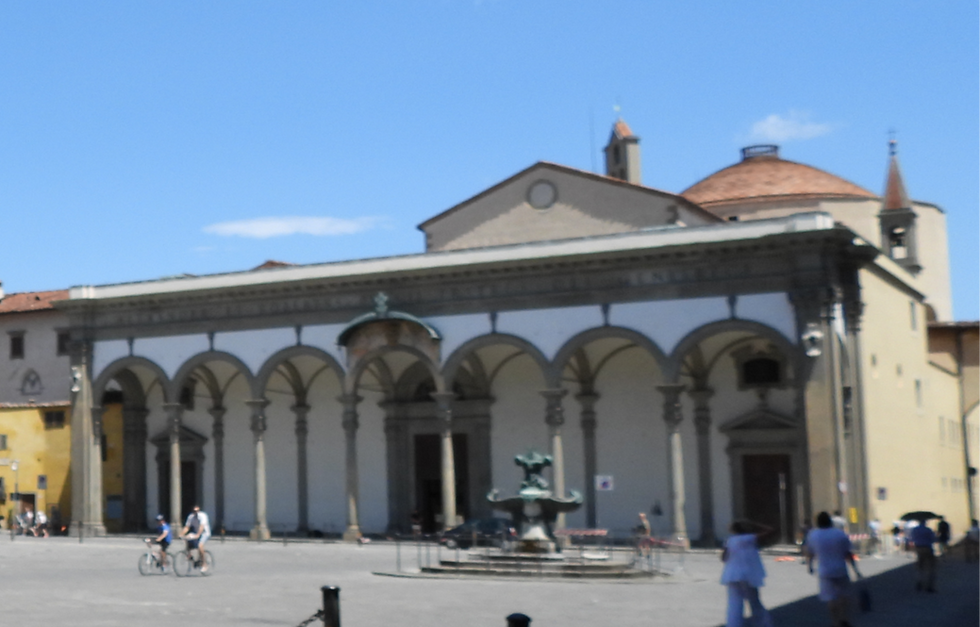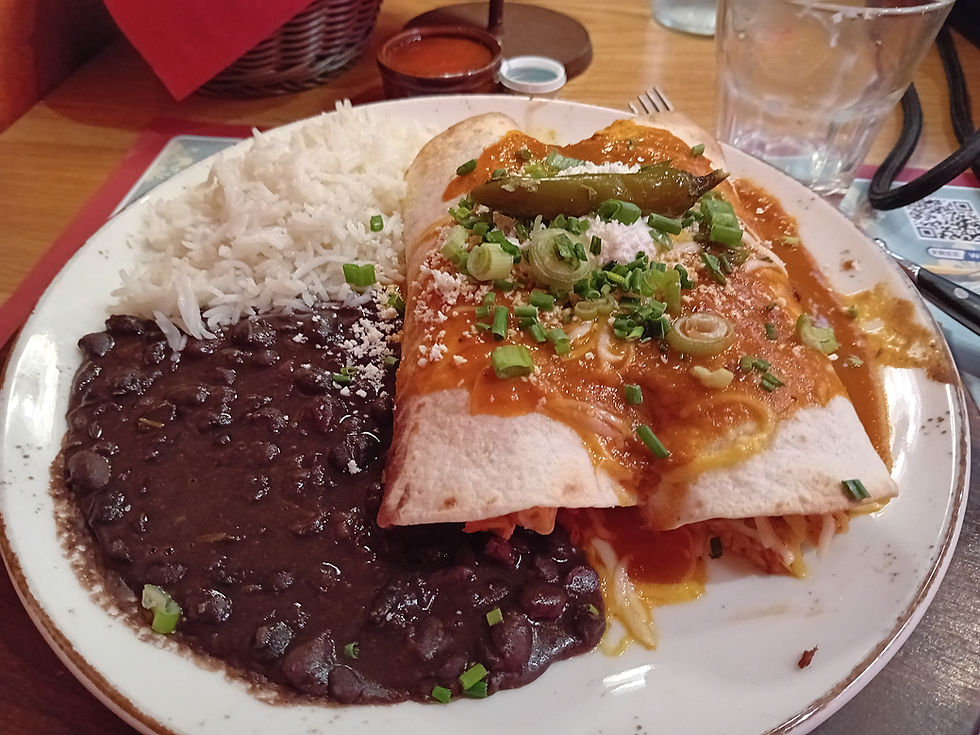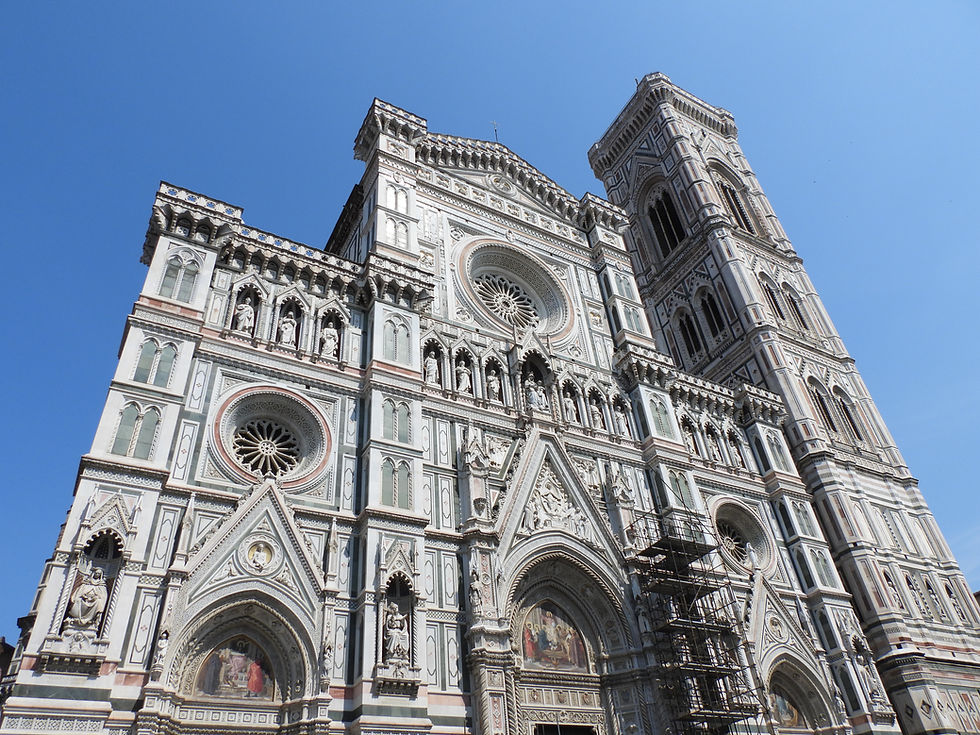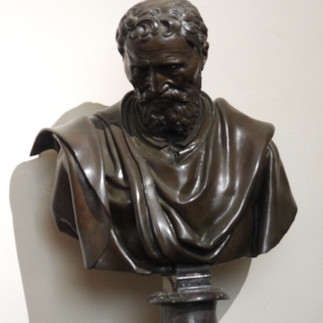Italy VII – 24-27 June - Florence / Firenze
- KB Cook

- Sep 25, 2023
- 14 min read
Updated: Oct 23, 2023
Checking out in Pisa took a bit longer than I anticipated, as a teenager was covering the front while the receptionist was off serving breakfast to guests. Still, being very close, I was at the station with enough time, and boarded the slightly late 5-carriage local bound for Florence.
Here is my observation about the station: “Firenze Santa Maria Novella (SMN) is evil. Funnel points, no maps. Anyone with a roller bag was faced with stairs – no ramps or mechanical movers. Lots and lots of people."
Google Maps provided good directions to my lodgings, but, once again, Expedia failed to pass along critical entry information. Fortunately, two women from Oz who were also staying in the extended flat were able to give me entry at both the street and to the door up a long (22 steps), steep flight of stairs.

I left my bags and headed back across the plaza in front of SMN to an office where I had to register, getting my passport photocopied again. I had the access codes I’d need, but I had two preplanned events and headed to the Duomo for the first. After getting some shots of the exterior of the cathedral, I scoped out the tour starting point. The nearby Basilica Santuario della SS. Annunziata was open, so I toured its interior, before being chased out for the midday closure
I had enough time to get lunch and slipped into Ristorante Mamma Napoli for a Caesar salad (insalata mista, rucola, pancetta, petto di pollo alla griglia, scaglie di Grana Padano) and a bowl of ribollita (Tuscan vegetable bread soup) with a bottle of water.
I returned to the Lindt chocolate shop, the tour starting point, and found about 20 folk milling around. There had been some emails about cancellations, but they were unclear, and the GetYourGuide site never cancelled. (Nor did Viator which sold the same tour.) After several phone calls, the actual provider verbally confirmed (but never was physically there) that the tour was cancelled due to the cathedral being closed. An utter clusterf**k, at least 2 dozen folk were left in the lurch.

Dejected, I decided to return to the lodgings and rest. I made the half hour walk back, initially putting the wrong address into Maps so the trip took me an hour and a half. Fortunate happenstance, I walked through the Piazza di San Lorenzo, passing the Basilica di San Lorenzo. This church had been the Florence cathedral before Santa Maria del Fiore. As I neared the residenza, I snagged 4 bananas before keying the codes into both doors. Keys to my assigned room were on the table, so I rolled my bags down a long hall to the room. Small, it had an en suite bath, window opening out to a space over a garden restaurant. Moving some of the furniture around, I was able to open the large roller. No shelf space in the head, so the small desk served that purpose, and I’d do any writing or typing out in the common space. No air conditioning, and Florence was in the midst of a heat wave. Checking with the Australian women, they explained they had raided one of the other rooms for a fan. Following their example, I found not only a floor fan, but the extra pillow that I lacked.
Meanwhile, the second event planned triggered – a boat ride on the Arno. I completely forgot about this, what with the failed Duomo tour, the extra long walk back, and situating the room. I took a laydown for a bit and then headed out to find dinner. Most diners were eating earlier than usual, as there were fireworks scheduled over the Arno for 9:30. Into Osteria Maso, I ordered water, salami Toscano e olivo, penne alla Carrettiera (red spicy sauce, garlic, tomato) and pizza Masó (spicy sausage, sausage, wurstel, ham, mozzarella.) The pasta sauce was feisty! Excellent with grated cheese – a real vegetarian winner. The pasta was al dente and yummy.
Sunday morning, my phone alarm woke me at 8 as I’d slept well in the cramped boxed-in space the mattress occupied, and checked my calendar (something I’m supposed to do nightly.) I had a ticket waiting for me at 9 at the Accademia. After a quick shower, the Map link took me to the cathedral, and fortunately, the museum is 500m away. The tour provider checked me in and then had me wait while he formed up groups. Apparently being the only single, he had me fill in so we were a group of 9. [It was the group from hell. A family of 5, with the father a terrier herding his rather young son; a trio in polka dots, who were constantly positioning themselves to take selfies.] The guide was an older guy, Andreas, I think, who wore Madras shorts, led at a brisk pace, and wasn’t very chatty between stops. He was also very opinionated regarding all the art we viewed.
Into the Accademia, and our first stop was the Michaelangelo Gallery, with 6 incomplete sculpture works lining the hall leading to the rotunda with the David. Andreas moved us into the rotunda and gave us time for photos, then brought us back to briefly talk about the unfinished works. Then we moved into a side gallery where the walls were filled with religious oil paintings. Crossing past the David, we were then herded into a sculpture gallery with hundreds of busts filled shelves lining the walls. Statues filled the center of this relatively narrow space, and some oil paintings were hung above some of the shelves. In both galleries we were limited to about 10 minutes each. As we were exiting, we briefly visited a room with Byzantine altarpieces.
Andreas then took off at a brisk pace, passing the Duomo, where he commented on the façade and the doors to both the cathedral and the baptistry. Then we set off at a near trot to the Piazza della Signoria, with a cursory narrative coming through our earphones as we passed numerous buildings, heading to the Loggia. A surprise awaited us, as we ran into the preparation for a reenactment in full costume of a “fight”.
Andreas stopped us outside the loggia where, while he talked, we were able to get shots of these masterpiece sculptures. Continuing, we strolled along the Piazzale degli Uffizi, with the full-sized statues of many historic notables set in niches in the columns supporting the loggia. Turning around, we headed to the museum’s entrance.
At about 11 we “jumped the line” and climbed three sets of stairs to the top level. Andreas led us to specific galleries where he expressed his opinions on the related art, history and politics of the works on display. Upon seeing a long line to view the red-walled Tribunal, he took us around to a side entrance where we briefly were able to get into the octagonal room containing the most important antiquities along with High Renaissance paintings, created in the late sixteenth century. Here’s where taking Art Appreciation in college would have helped, something my cramped schedule as an undergraduate engineering student never had the opportunity to take. But I did see many works of art that I recognized.
Off to the end of the hall, we banked around and headed to the galleries of works by Michaelangelo and DaVinci. After almost precisely an hour, Andreas ended our tour, but told us we could stay and explore on our own. I backtracked to the starting point on the top floor, and began a more methodical tour of the galleries. More pictures, including many of the ceilings. Once I’d seen what I wanted to, I descended a flight to galleries filled with more religious art. I found the gallery with the Caravaggio Medusa, a stunning painting on a shield. Three-plus hours after entering, and more than 300 photos, I finally returned to real-time. Leaving the Uffizi, I walked upstream along the Arno, past where I was supposed to cruise from the evening before to cross the river on the Ponte all Grazie. My ultimate objective was to return across this divide on the Ponte Vecchio.
My notes are sparse about my time on the southern side. I recall thinking of trying to get to the Pitti Palace and the Boboli Gardens, both of which are admission-by-ticket, but I think I only got as far as the Chiesa di Santa Felicita (closed) on the hill I climbed. Crossing the bridge, I joined a mass of tourists, albeit I barely looked in the shops vending jewelry, leather goods and trinkets.
With an objective to return to my room, I began a wander through the smaller streets, finding bits of art, interesting buildings, and the church (Chiesa di San Salvatore in Ognissanti) where Amerigo Vespucci is buried. My last shot on the Nikon for the day was an antique shop’s window, with small toy cars and motorcycles being offered.
When I got to the lodgings, I noticed a reply text message from the morning. The night before, experiencing miserable WiFi, I’d sent a request. His reply directed me to do what I tell folks frequently – power cycle the router. His message included its location, so I was able to do so, and (miraculously) the internet service improved significantly, particularly in the common space. I read Inferno, the Dan Brown paperback I’d been trying to finish, and then took a nap before heading out to dinner.
Choosing Mexican food, most likely because I had passed up many other options, I ordered chilititos (jalapeno poppers?) and an enchilada classica platter. I wrote about a page and a half in my journal, not writing anything about the food. I was still abstaining to give the gout a chance to retreat, and afterwards headed back to backup data and read emails.


Monday morning broke with sunshine and promised to be another scorcher. My booking to climb the Brunelleschi Dome and tour the Duomo had been rescheduled, so I decided to head out and see the two cathedral sites in Fiesole. A hilltop town about 5km north of the city, the bus boarded around the far side of SMN. With round trip tickets, I rode to the top, exiting at the terminus.

Directly across the road stood the Cattedrale di San Romolo / Cathedral of St. Romulus, its square belltower rising to about double the high of the vault over the apse. A clock faced out towards Florence, and its cap was crenellated like a fortress. The exterior walls bore narrow slit windows about a story up, with more in the gallery.
Circular stone columns supported thick stone walls with those gallery windows on one side. The wooden vault ran the length of the nave, with a two-level sanctuary behind the main altar at the east end. Heading to the apse, I descended to the lower level where the baptismal font was in a sunlit alcove, A tall cast-iron fence blocked access to the space below, the squarish altar housing a tomb, an enameled tabernacle sitting at the center. Interesting frescoes filled some of the arches supporting the ceiling. Climbing and crossing to go upstairs, a golden triptych stands on the high altar under a dome filled with panels of depictions of the Passion. A simple older church, the cathedra is a carved wooden seat under a canopy, indicating its cathedral status.
Leaving, I climbed the stairs across the stone plaza to the front of the bishop’s residence. From that vantage point, I was able to get a good representative shot. Back and across to the bus stop, I looked out from the rampart over the city of Firenze below. Picking up a separate “local” ticket, I waited on the bus to take me down several steep switchbacks to drop me off at the Convento di San Domenico.

I backtracked to the cross-valley road and began walking downhill towards the university buildings and the Badia Fiesolana, which had been the previous site of the cathedral. Arriving at a parking lot surrounded by numerous international flags, I looked over the wall to the valley below and the town across. The church is rectangular stone building. The western façade, reached by a set of seven steps, is gray and white stone in a geometric layout, covering only the entry and about a third of the face of the building. The door was cracked open, so I slipped through and walked into the nave. Three chapels are built into the side aisles, while the central nave is filled with wooden bench pews. Five steps lead up to the apse, where I found an open coffin placed in front of the main altar. Behind the main altar, and behind a marble altar rail, an elaborately carved marble high altar with multicolored inlays was three steps up.
Leaving the church, knowing that a “viewing” was in place, I made sure not to completely close the door. I began my walk up the hill to the convent and bus stop, observing the olive trees that filled the downward slope. Back at the stop, I had a 5-minute wait, and soon was back at the SMN station.

I walked to the Duomo, getting there 90 minutes before my next tour, and decided to join the “unticketed” line. Half an hour later (I just missed a cut, and waited 8 minutes), I was admitted, and I began my exploration of the Cattedrale di Santa Maria del Fiore, or at least those portions which weren’t roped off. [Interestingly, the woman who had been in front of me in the queue and just made the cut came out before I got in.] [Also to note: most of the floor and side areas are roped off, requiring a ticket to get past.]
The western façade, indeed, the entire exterior of the cathedral, is brilliant. Red, white and green marbles are used to make horizontal stripes on the sides, and to be accents for the statues and Gothic ornamentation that covers the front. This blazing beauty had set my expectations for the interior, expecting something to rival the rococo interiors I’d seen in several of the Swiss cathedrals on this trip. Well, boom! The interior of Santa Maria del Fiore is relatively plain. The stolid blocky columns rise to no-nonsense gothic arches, the walls are bare. Only the elaborate patterning of the floor, in those three colors of marble, brought some attention to the space. Several memorials with statues and writing are placed against walls. The Brunelleschi Dome interior, an octagonal set of rings up to a lantern, is filled with gorgeous paintings. I have to admit that I was underwhelmed; I only took 70 pictures for such a large space, and was out in a half hour.
With thirty minutes until my walking tour, I strolled down to the Palazzo Vecchio and spent my time waiting by admiring the Neptune fountain and the statues in the loggia. Needing a facility, I got a bottle of water and an arugula, parmesan and Parma ham on focaccia hero. Finding my coordinator, I checked in and was told to finish my lunch. Split by language into groups, we were 7 (4 from San Antonio, TX and a pair from Birmingham, UK) assigned to a Ukrainian woman named Diana. (Feedback from the group was that she was difficult to understand, and she seemed to have some issues coming up with the right words.) The theme of this walk was “Dan Brown’s Inferno”, so she started by taking us to the birthplace of Dante Alighieri. The Chiesa di Santa Margherita dei Cerchi, where Dante had been baptized was next on the tour. At the Baptistry, Diana pointed out the representation of the sculpturer’s visage, before we returned to the museum in the Old Palace.
First stumbling block, the guard insisted that all bags be checked, so we all tromped off to the lockers while she tried arguing. Back together, we mounted the stairs and the group began speed walking through the exhibits. With my camera, I was always the laggard, missing her commentary. I was mesmerized by the ceiling and walls, all covered with paintings. Lighting was a challenge, and my pictures flip back and forth between being dark and overexposed. The grand hall was being used for a lecture, so we had limited access to this magnificent space. Probably the high point of the tour was the death mask, which had featured so significantly in the book which I’d finished a week later. Our tour ended after we’d been in the map room, but I was able to slip back in and continue to appreciate all the art (and especially the ceilings) in the museum.
Leaving the museum at five, I pretty much duplicated my walk back to my lodgings from the day before, but I refilled my water bottle at one of the city fountains before I started. Leaving my room door open with the fan on and the shuttered window open, I got some good cross breezes while I did email on my phone. When I tried to use the Chromebook for an internet search for a Malta tour, the WiFi failed. So I took a nap and then headed out for dinner.
Going for Tuscan, I got a seat at La Carabaccia where I started with a simple salad of arugula and cherry tomatoes. Tagliatelle with wild boar ragout for a main, and pistachio crème brulée for dessert. I’d planned on a second salad, raw violetto artichoke salad with grana Padano riserva, but artichokes were out of season.
Tuesday would be my last full day in Firenze, and my plans were in disarray. What was listed in the itinerary was from the 2020 trip, and I’d not duplicated all the elements. So I was winging it. I dallied, not leaving the room until 10 and heading first to the Chiesa di Sant’Ambrogio e San Giuseppe. Free admission, the single-aisle nave has four niche memorials on each side and a renowned marble altarpiece in the chapel to the north of the main altar.
Heading into the Basilica di Santa Croce, I paid the 8€ admission. A big church, there are several monumental memorials to notables, such as Gioachino Rossini (moved in 1867 from Père Lachaise in Paris), Niccolò Machiavelli, Dante Alighieri (buried in Rimini), Enrico Fermi (buried in Chicago), Galileo Galilei, Leonardo DaVinci (buried in Amboise, France) and Michaelangelo Buonarroti. While the church feels like a cross between a cemetery and a mausoleum, I really enjoyed venturing into the sacristy. I was able to see the Cimabue icon-cross that became the symbol for the restoration and recovery efforts in Florence after the 1966 flood. Numerous other works, great art, fill the walls of Santa Croce. I spent seventy-five minutes there before venturing out to the cloisters.
Leaving the basilica about one, I began my saunter to the Accademia where my last Florence tour would begin at three. Intervening streets were relatively clear, but the crowds reappeared as I passed the Duomo and walked towards the museum. First getting a bottle of water, and then, around the corner (and avoiding the long line to get a panini from one of “the places”) to a small café for a turkey and arugula panini. I sat on a curb in a park, under a tree, and waited until it was time, meanwhile watching the pigeons squabble over crumbs and crusts.
We were a group of 14, mainly from the States, led by Riccardo. There was a delay of 20 minutes getting in, triggering an accelerated visit. First into the painting gallery to look at the Botticelli, as he had been Michaelangelo’s teacher. Then to the “nave” of the unfinished sculptures to cover “The Prisoners” and “San Pietro” before we were given 2 minutes to get pictures of the “David”. A WC break followed, then a walk to the cathedral. We looked at the rear, and then the interior of the dome over the altar. Crossing to the Baptistry, we were confronted with scaffolding in the center where a mosaic was being conserved. We had time to view the many mosaics, particularly in the vaults and below the openings of the gallery. Geometric tilework covered the floor, in patches of repeated patterns.
Outside again, Riccardo walked us to the side entrance of the cathedral, where the timed queue for the dome climb assembled. With 15 minutes before our climb, the guide split. (Yes, he’d been with us 75 minutes. Tough job!) As we moved to enter, those of us (me included) were instructed to go put our bags in a locker. Returning, slightly winded, we were pushed to the front and began the 400+ step climb. Breaks in the climb allowed us to see statues removed from the façade, views up to the dome and down to the floor. Once at the top, we were higher than the belltower, getting a great view of the Tuscan countryside and sprawling city. I even spotted the cathedral in Fiesole. The climb included a walk around the rim of the inside of the dome, getting very close to the massive painting, and then getting to climb to the lantern, the center of the dome. This was a really awesome climb.
It took about 15 minutes to descend, slowly coming down from the psychological high as well. Passing the Chiesa sei Santi Michele e Gaetano, I just had to poke in – the archangel is one of those celestial beings I pray to. It was an impressing nave, but I was churched out. I managed to walk back without the aid of Maps, and chilled for about an hour. The newest arrivals in the flat, a trio from Australia, were eating in the common space, and we chatted for a bit, trading suggestions and hints. I went to the restaurant next door, where I found the music a bit loud. I started with a Grimburger, an unfiltered ale, and switched to a double ambrée to go with my burger and fries.
The meter-square shower in the flat in Florence has a rickety shower stall, where the plastic walls seem to have a tenuous attachment to the plastic frame, and the sliding doors in one corner are difficult to slide. I was in fear that the whole mess would collapse during my 4-day stay, but I was able to get a last shower after finishing my packing, and headed out the door. I congratulated myself that I didn’t kill myself on the extremely steep and shallow steps while making the two trips with mey gear to the street. I made all the right turns getting to the stairs at the SMN station, weaved through the throngs of people to find the platform. Once on board with the bags situated, I had a seat facing towards the rear for the 90-minute ride to Siena, and did email on the phone.

You can purchase your own copy
(or have me send it as a gift) of Cathedrals to the Glory of God
by clicking this link:





















































































































































Comments